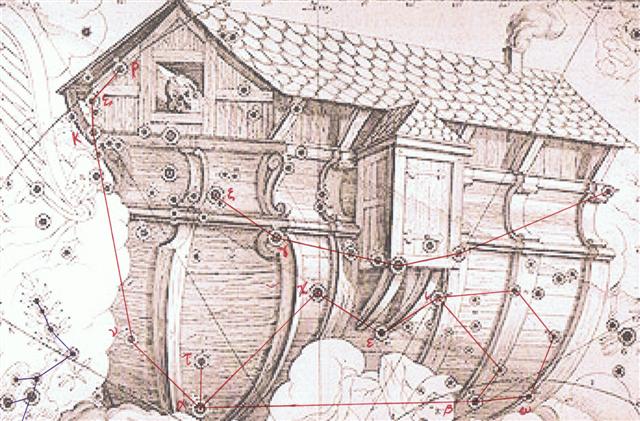|
7. The details of the original shape of the Ship are forgotten, but its idea remains. The Ship is at the origin of current time and its captain is Noah, the last king of the preceding time:  I have drawn dark lines for Columba Noachi at bottom left and with red lines and letters identified the basic layout of his house, oriented with higher right ascension to the right in the same manner as Hevelius. Noah is the last antediluvian king and he has many names (cfr at Camp 8). I should write in the present tense because this was probably the mode of expression before dawn - in mythic time before time was divided into past, present, and future, before the structures of the modern languages were defined by Noam Chomsky.
Clearly 18600 and 36000 in the Sumerian lists should be read as 186 respectively 360 days, and - we remember - the position of Antares is glyph number 186 in the G text. Another name, equivalent with Noah, was Utnapishtim (cfr at Camp 6): ... Utnapishtim is spry enough to tell [Gilgamesh] in great detail the story of the Deluge. He tells how Enki-Ea has warned him of Enlil's decision to wipe out mankind, and instructed him to build the Ark, without telling others of the impending danger. 'Thus shalt thou say to them: (I will ... go) down to the apsu and dwell with Ea, my (lor)d.' He describes with great care the building and caulking of the ship, six decks, one iku (acre) the floor space, as much for each side, so that it was a perfect cube [a sign of Saturn], exactly as Ea had ordered him to do. This measure '1-iku' is the name of the Pegasus-square, and the name of the temple of Marduk [the spring sun god] in Babylon, as is known from the New Year's Ritual at Babylon, where it is said: 'Iku-star, Esagil, image of heaven and earth.' Allen: "The Biblical school of course called it Noah's Ark, the Arca Noachi, or Archa Noae as Bayer wrote it; Jacob Bryant, the English mythologist of the last century, making its story another form of that of Noah. Indeed in the 17th century the Ark seems to have been its popular title." I have copied the picture of the Ark above from Linda Hall's internet site, where she informs us that it is from Julius Schiller's Coelum stellatum Christianum (Augsburg, 1627): "Schiller's Christian Starry Heavens was aptly named, for in this atlas, Schiller replaced all of the pagan constellations with Christian counterparts. The twelve zodiacal constellations ... were renamed for the twelve apostles; so that Taurus the Bull, for example, became St. Andrew. Other notable replacements include The Red Sea for the river Eridanus; the Ark of Noah for the Ship of the Argonauts ... and the Sepulcher of Christ for Andromeda." |
||||||||||||||||||||||||||||||||||||||||||||||||||||||||||||||||||||||||||||||||||||||||||||||||||||||